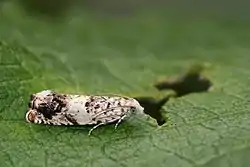Epinotia subocellana
Epinotia subocellana is a species of moth of the family Tortricidae. It is found in Asia and Europe and was first described by Edward Donovan in 1806.
| Epinotia subocellana | |
|---|---|
 | |
| Epinotia subocellana | |
| Scientific classification | |
| Kingdom: | |
| Phylum: | |
| Class: | |
| Order: | |
| Family: | |
| Genus: | |
| Species: | E. subocellana |
| Binomial name | |
| Epinotia subocellana (Donovan, 1806) | |
| Synonyms | |
| |
Life cycle
The male and female moths are similar with a wingspan of 10–14 mm.[2] They fly from May to July at dusk and come to light.[3] .
Larva
Larvae have a yellowish or greenish-white body and a yellowish-brown head. The prothoracic and anal plates are pale yellow. They live in a sandwich of two leaves spun together, feeding on the underside of the upper leaf, from August to October. Foodplants include eared willow (S. aurita), grey willow (S. cinerea) and goat willow (S. caprea).[4]
Distribution
Found from western, northern and central Europe through to eastern Russia.[4]
References
- "Epinotia subocellana;; (Donovan, 1806)". GBIF Global Biodiversity Information Facility. Retrieved 27 December 2018.
- Emmet, A Maitland (1998). A Field Guide to the Smaller British Lepidoptera (Second ed.). London: The British Entomological and Natural History Society. p. 180. ISBN 0 9502891 6 7.
- Kimber, Ian. "Epinotia subocellana". UKmoths. Retrieved 27 December 2018.
- Bradley, J D; Tremewan, W G; Smith, Arthur (1979). British Tortricoid Moths. Tortricidae:Olethreutinae. London: The Ray Society. pp. 102–03. ISBN 0 903874 06 7.
This article is issued from Wikipedia. The text is licensed under Creative Commons - Attribution - Sharealike. Additional terms may apply for the media files.